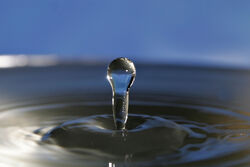
Water is easy to take for granted. Today, by turning a tap, all the water in the world will pour right into your cup, but for millennia, it was not that easy: water had to be fetched from a well or river. But once the zombie apocalypse happens, filling your glass will be more work than ever: it must be purified. With the widespread propagation of waterborne pathogens, all water in the wild is to be considered suspicious.
The probability of infectious water would not have been a problem if humans did not need water so badly. But we do: the Isreali government and military did extensive research and found that the human body requires for peak performance one liter per hour of strenuous labor (combat) in the desert.
Many wilderness survival programs and FEMA advise one gallon (3.79 liters) a day. Now, most water intakes aren't that high. Actual daily intake, according to wikipedia, ranges from one to seven liters.
So, in the fictional context of zombie outbreaks, where does water come from?
Bottled water is an obvious solution. It is portable, pretty safe from spilling, and the bottles could be refilled. It is sold, typically in clear plastic bottles, which can be reused later. It is not cheap, but is not really that costly today. However, it is a recorded fact that bottled water is stockpiled and hoarded before and during civil unrest. What that means is that, although plentiful today, at the first sign of low pressure on the doppler, zombies, power outages, or any other manifestation of civil unrest, the supply of bottled water will almost instantly go to zero. So while convenient during peacetime, getting bottled water during any civil unrest is nonviable.
Storing personal supplies of water is the next logical step. There are many ways to do this, but the simplest way would be to buy bottled water and put it on the shelf. Keep the bottles closed and they should remain viable for long periods of time.
Water can also be stored in rinsed two liter bottles along with 1-3 drops of unscented chlorine bleach.
These are all good methods to store water, but they have problems: the water can stagnant, it takes up space and can be expensive.
Taking water from a building can be an important source of water.
In multiple story buildings, water can remain in the pipes, waiting for use. To collect the residue, start at the top. Hold a pitcher under the uppermost faucet, and turn it on. Catch any water and leave the faucet in the on position, before moving to a lower faucet in the building. When the lowest faucet is turned the weight of the water should push any remaining water into the pitcher. Bear in mind that the plumbing might not be level, so multiple faucets might bear water on the lower level, or even higher. All faucets should be checked.
The reservoir tank of a toilet typically holds one and a half gallons of clean water. The water in the bowl can be rendered drinkable, but should be avoided if possible.
Hot water heaters contain gallons of perfectly drinkable water, but the water can be burning hot, especially if the power only recently went out for an electric model or, for a gas operated model, the gas is still operational or recently stopped. Before draining a hot water heater, deactivate whatever heating elements or flames heat the water at risk of fire, unit damage and personal injury. Most units have a spigot at the bottom for draining and cleaning out the sediment. This is the best way to fill pitchers and bucket for use, but any sediment will come out with the water. A filter will take out the sediment, certainly, but it will quickly clog any filter. Let the water sit until the sediment settles before using a siphon to remove the clean water.
Water is obviously available in naturally occuring waterways, ponds, rivers, streams and springs. Water is likely to be available here long after the Dasani is gone, but to drink untreated water likely means giardia, cholera, tapeworms, and dysentery.
Purifying water is important. There are many ways to do it, but some are quite simple.
Boiling water is a very good way to do it, though it does require some resources. Simply bringing water to the boiling point should make it safe to drink. However, bear in mind that while boiling will kill pathogens in the water, other impurities, such as chemicals, may remain in the water. It is not necessary to boil it for any length of time. Instead of letting it cool before drinking, why not make tea, bush tea, coffee, hot chocolate or soup? Adding to it will make it more palatable, warm the drinker, and provide more nutrition.
Ultraviolet light is used in purifying water very successfully. The rays can come from an expensive pen available at camping stores, or the rays can come from the sun. To utilize the sun, put clear water in a clear bottle (such as a disposable one) and let it sit in direct sunlight for a few hours. The effectiveness of this method is affected by a few variables: water clarity, and strength of sunlight, but it does work if given time.
Water purification tablets work by inducing a chemical into the water that kills the pathogens. The dose is theoretically low enough to be safe for humans. For use, refer to directions included on packaging.
Filters are also used to purify water. They are expensive, maintenance intensive, and require frequent new filters. For use, refer to directions included on packaging.
Distilling can be a very good way to purify water from some poisons, as well as diseases. Apparatus is complicated and labor intensive; and the resulting water has a distinctive taste.
